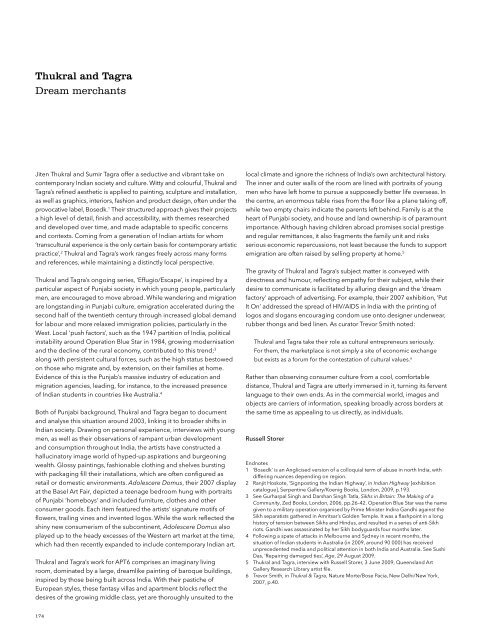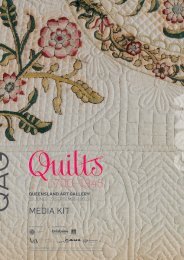Queensland Art Gallery - Queensland Government
Queensland Art Gallery - Queensland Government
Queensland Art Gallery - Queensland Government
Create successful ePaper yourself
Turn your PDF publications into a flip-book with our unique Google optimized e-Paper software.
Thukral and Tagra<br />
Dream merchants<br />
Jiten Thukral and Sumir Tagra offer a seductive and vibrant take on<br />
contemporary Indian society and culture. Witty and colourful, Thukral and<br />
Tagra’s refined aesthetic is applied to painting, sculpture and installation,<br />
as well as graphics, interiors, fashion and product design, often under the<br />
provocative label, Bosedk. 1 Their structured approach gives their projects<br />
a high level of detail, finish and accessibility, with themes researched<br />
and developed over time, and made adaptable to specific concerns<br />
and contexts. Coming from a generation of Indian artists for whom<br />
‘transcultural experience is the only certain basis for contemporary artistic<br />
practice’, 2 Thukral and Tagra’s work ranges freely across many forms<br />
and references, while maintaining a distinctly local perspective.<br />
Thukral and Tagra’s ongoing series, ‘Effugio/Escape’, is inspired by a<br />
particular aspect of Punjabi society in which young people, particularly<br />
men, are encouraged to move abroad. While wandering and migration<br />
are longstanding in Punjabi culture, emigration accelerated during the<br />
second half of the twentieth century through increased global demand<br />
for labour and more relaxed immigration policies, particularly in the<br />
West. Local ‘push factors’, such as the 1947 partition of India, political<br />
instability around Operation Blue Star in 1984, growing modernisation<br />
and the decline of the rural economy, contributed to this trend; 3<br />
along with persistent cultural forces, such as the high status bestowed<br />
on those who migrate and, by extension, on their families at home.<br />
Evidence of this is the Punjab’s massive industry of education and<br />
migration agencies, leading, for instance, to the increased presence<br />
of Indian students in countries like Australia. 4<br />
Both of Punjabi background, Thukral and Tagra began to document<br />
and analyse this situation around 2003, linking it to broader shifts in<br />
Indian society. Drawing on personal experience, interviews with young<br />
men, as well as their observations of rampant urban development<br />
and consumption throughout India, the artists have constructed a<br />
hallucinatory image world of hyped-up aspirations and burgeoning<br />
wealth. Glossy paintings, fashionable clothing and shelves bursting<br />
with packaging fill their installations, which are often configured as<br />
retail or domestic environments. Adolescere Domus, their 2007 display<br />
at the Basel <strong>Art</strong> Fair, depicted a teenage bedroom hung with portraits<br />
of Punjabi ‘homeboys’ and included furniture, clothes and other<br />
consumer goods. Each item featured the artists’ signature motifs of<br />
flowers, trailing vines and invented logos. While the work reflected the<br />
shiny new consumerism of the subcontinent, Adolescere Domus also<br />
played up to the heady excesses of the Western art market at the time,<br />
which had then recently expanded to include contemporary Indian art.<br />
Thukral and Tagra’s work for APT6 comprises an imaginary living<br />
room, dominated by a large, dreamlike painting of baroque buildings,<br />
inspired by those being built across India. With their pastiche of<br />
European styles, these fantasy villas and apartment blocks reflect the<br />
desires of the growing middle class, yet are thoroughly unsuited to the<br />
local climate and ignore the richness of India’s own architectural history.<br />
The inner and outer walls of the room are lined with portraits of young<br />
men who have left home to pursue a supposedly better life overseas. In<br />
the centre, an enormous table rises from the floor like a plane taking off,<br />
while two empty chairs indicate the parents left behind. Family is at the<br />
heart of Punjabi society, and house and land ownership is of paramount<br />
importance. Although having children abroad promises social prestige<br />
and regular remittances, it also fragments the family unit and risks<br />
serious economic repercussions, not least because the funds to support<br />
emigration are often raised by selling property at home. 5<br />
The gravity of Thukral and Tagra’s subject matter is conveyed with<br />
directness and humour, reflecting empathy for their subject, while their<br />
desire to communicate is facilitated by alluring design and the ‘dream<br />
factory’ approach of advertising. For example, their 2007 exhibition, ‘Put<br />
It On’ addressed the spread of HIV/AIDS in India with the printing of<br />
logos and slogans encouraging condom use onto designer underwear,<br />
rubber thongs and bed linen. As curator Trevor Smith noted:<br />
Thukral and Tagra take their role as cultural entrepreneurs seriously.<br />
For them, the marketplace is not simply a site of economic exchange<br />
but exists as a forum for the contestation of cultural values. 6<br />
Rather than observing consumer culture from a cool, comfortable<br />
distance, Thukral and Tagra are utterly immersed in it, turning its fervent<br />
language to their own ends. As in the commercial world, images and<br />
objects are carriers of information, speaking broadly across borders at<br />
the same time as appealing to us directly, as individuals.<br />
Russell Storer<br />
Endnotes<br />
1 ‘Bosedk’ is an Anglicised version of a colloquial term of abuse in north India, with<br />
differing nuances depending on region.<br />
2 Ranjit Hoskote, ‘Signposting the Indian Highway’, in Indian Highway [exhibition<br />
catalogue], Serpentine <strong>Gallery</strong>/Koenig Books, London, 2009, p.193.<br />
3 See Gurharpal Singh and Darshan Singh Tatla, Sikhs in Britain: The Making of a<br />
Community, Zed Books, London, 2006, pp.26–42. Operation Blue Star was the name<br />
given to a military operation organised by Prime Minister Indira Gandhi against the<br />
Sikh separatists gathered in Amritsar’s Golden Temple. It was a flashpoint in a long<br />
history of tension between Sikhs and Hindus, and resulted in a series of anti-Sikh<br />
riots. Gandhi was assassinated by her Sikh bodyguards four months later.<br />
4 Following a spate of attacks in Melbourne and Sydney in recent months, the<br />
situation of Indian students in Australia (in 2009, around 90 000) has received<br />
unprecedented media and political attention in both India and Australia. See Sushi<br />
Das, ‘Repairing damaged ties’, Age, 29 August 2009.<br />
5 Thukral and Tagra, interview with Russell Storer, 3 June 2009, <strong>Queensland</strong> <strong>Art</strong><br />
<strong>Gallery</strong> Research Library artist file.<br />
6 Trevor Smith, in Thukral & Tagra, Nature Morte/Bose Pacia, New Delhi/New York,<br />
2007, p.40.<br />
Thukral & Tagra<br />
Jiten Thukral<br />
India b.1976<br />
Sumir Tagra<br />
India b.1979<br />
Immortalis (from ‘Effugio’ series) 2008<br />
Synthetic polymer paint and oil on resin / 76 x 72cm /<br />
Image courtesy: The artists and <strong>Gallery</strong> Nature Morte,<br />
New Delhi<br />
Next page<br />
Thukral & Tagra<br />
Dominus Aeris – The Great, Grand Mirage (detail) 2009<br />
Synthetic polymer paint and oil on canvas / Triptych:<br />
213.5 x 213.5cm (each) / Image courtesy: The artists<br />
and <strong>Gallery</strong> Nature Morte, New Delhi<br />
174 175
















